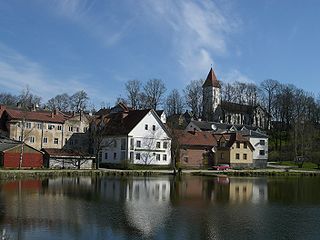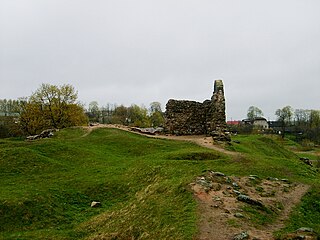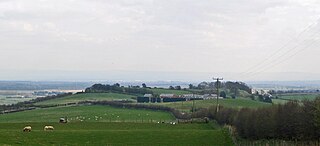The Northern Crusades or Baltic Crusades were Christian colonization and Christianization campaigns undertaken by Catholic Christian military orders and kingdoms, primarily against the pagan Baltic, Finnic and West Slavic peoples around the southern and eastern shores of the Baltic Sea, and also against Orthodox Christian Slavs.

Dinas Emrys is a rocky and wooded hillock near Beddgelert in Gwynedd, north-west Wales. Rising some 76 m (250 ft) above the floor of the Glaslyn river valley, it overlooks the southern end of Llyn Dinas in Snowdonia.

A hillfort is a type of earthwork used as a fortified refuge or defended settlement, located to exploit a rise in elevation for defensive advantage. They are typically European and of the Bronze Age or Iron Age. Some were used in the post-Roman period. The fortification usually follows the contours of a hill and consists of one or more lines of earthworks, with stockades or defensive walls, and external ditches.If enemies were approaching the civilians would spot them from a mile away.

Talsi is a town in Latvia. It is the administrative centre of Talsi Municipality. It is nicknamed the "green pearl of Courland".

Tukums is a town in the Zemgale region of Latvia.

Rēzekne is a state city in the Rēzekne River valley in Latgale region of eastern Latvia. It is called The Heart of Latgale. Built on seven hills, Rēzekne is situated 242 kilometres east of Riga, and 63 kilometres west of the Latvian-Russian border, at the intersection of the Moscow – Ventspils railway and Warsaw – Saint Petersburg Railways. It is the 7th largest city in Latvia.

Barbury Castle is a scheduled hillfort in Wiltshire, England. It is one of several such forts found along the ancient Ridgeway route. The site, which lies within the Wessex Downs Area of Outstanding Natural Beauty, has been managed as a country park by Swindon Borough Council since 1971. It is on Barbury Hill, a local vantage point, which, under ideal weather conditions, commands a view across to the Cotswolds and the River Severn. It has two deep defensive ditches and ramparts.

Semigallians were the Baltic tribe that lived in the south central part of contemporary Latvia and northern Lithuania. They are noted for their long resistance (1219–1290) against the German crusaders and Teutonic Knights during the Northern Crusades. Semigallians had close linguistic and cultural ties with Samogitians.

Cadbury Castle is a Bronze and Iron Age hillfort in the civil parish of South Cadbury in the English county of Somerset. It is a scheduled monument and has been associated with King Arthur's legendary court at Camelot.

Hod Hill is a large hill fort in the Blackmore Vale, 3 miles (5 km) north-west of Blandford Forum, Dorset, England. The fort sits on a 143 m (469 ft) chalk hill of the same name that lies between the adjacent Dorset Downs and Cranborne Chase. The hill fort at Hambledon Hill is just to the north. The name probably comes from Old English "hod", meaning a shelter, though "hod" could also mean "hood", referring to the shape of the hill.
Viestards was one of the greatest Semigallian dukes in the 13th century, referred to as King Vester.

Bats Castle is an Iron Age hillfort at the top of a 213 metres (699 ft) high hill in the parish of Carhampton south south west of Dunster in Somerset, England.

Rēzekne Castle ruins are located in the downtown of Rēzekne, Latvia, a city in the center of Latgale. The castle served as a base of the local Livonian order landlords until the 16th century and also as the main military support base for battles against Russians and Lithuanians. Today, fragments of the stone walls and the foundation can be seen on the ancient castle hill.

Koknese Castle is a complex in Koknese, Latvia, dating from the 13th century. The castle was situated on a high bluff overlooking the Daugava river valley. In 1965 a hydroelectric dam was built downriver, creating a reservoir that partially submerged the castle and flooded the surrounding valley.

Sēlpils Parish is an administrative territorial entity of Jēkabpils Municipality in the Selonia region of Latvia. Prior to 2009, it was an administrative unit of Jēkabpils District. The administrative center is the village of Sēlija.

Eddisbury hill fort, also known as Castle Ditch, is an Iron Age hill fort near Delamere, Cheshire, in northern England. Hill forts are fortified hill-top settlements constructed across Britain during the Iron Age. Eddisbury is the largest and most complex of the seven hill forts in the county of Cheshire. It was constructed before 200–100 BC and expanded in 1–50 AD. In the 1st century AD, the Romans slighted the site. It was reoccupied in the 6th–8th centuries AD, and an Anglo-Saxon burh was probably established at Eddisbury in 914. In the medieval and post-medieval periods quarrying and farming have damaged the site. Ownership is currently split between the Forestry Commission and a local farm. Eddisbury is protected as a Scheduled Ancient Monument.

Talsu apriņķis was a historic county of the Courland Governorate and of the Republic of Latvia. Its capital was Talsi (Talsen).
Nameisis or Namejs was a Semigallian duke in the second half of the 13th century. He ruled in the western part of Semigallia, with his capital at Tērvete. In 1279–81, he led a Semigallian uprising against the Livonian Order, a crusading military order. Very little is known about his life. He is mentioned only in the Livonian Rhymed Chronicle and in some documents from the 14th century. For this reason he is sometimes referred as semi legendary ruler in Latvian historiography.
Hillforts are fortified settlements that were built across Europe in the Bronze Age, Iron Age, and, to a lesser extent, the Early Middle Ages. The following pages are lists of hillforts:

Sēlpils Castle is an ancient castle in Sēlpils Parish, Jēkabpils Municipality in the Selonia region of Latvia.
















